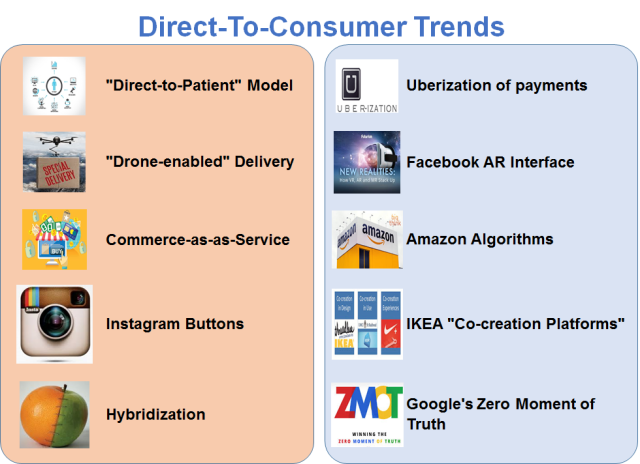Direct To Consumer Business Model Innovation & Emerging Trends: Part II
*Get your crypto project/offer published on this blog and news sites. Email:contact@cryptoexponentials.com

“The Best Service Is No Service” – Picked from authors Bill Price and David Jaffe, the best way to satisfy customers is eliminate the need for service altogether. The need of the day for DTC seller is to progress beyond offering personalized service to true customer excellency with “No Need for Service”.
In continuation of last series, elaborating further on direct to consumer business model innovation and evolving trends in direct-to-consumer marketplace that are fueling the growth. The following is summary of few of trends.
“Direct-to-Patient” Model: For example Telehealth, is likely a strong area of interest due to its potential for significant impact on care delivery. While virtual visits may have the ability to shift significant volumes of care and expand access, uncertainty remains for many institutions regarding reimbursement levels, compliance standards and best practices for planning. Very promising D2C model to keep an eye on.
“Drone-enabled” Delivery: D2C can really be fueled by drone-based delivery. The ideal candidates are replenishment products where shoppers essentially repeat-purchase, building online channels makes a lot of sense for a brand, especially in the age of 1-hour drone-enabled delivery. Repeat-purchase models also help the brand get and remain entrenched with shoppers, often opting for convenience and loyalty over price
Brand experience via “Commerce-as-as-Service”: Consumers are demanding a enriched experience. Direct-to-consumer business model combined with a distinctive, compelling and focused public-facing brand experience, lets manufacturers control and cultivate relationships with customers that transcend retail channels.
Instagram Buttons: PepsiCo is one of the classic use case of leveraging Instagram Buttons for its D2C strategy. PepsiCo succeeded selling its IZZE – a range of carbonated drinks – aimed to sell online effectively to ‘hipster millennials’ by following e-commerce trends in Instagram buttons, links to Amazon and early adoption of Amazon Dash buttons
Hybridization: The hybridization of brick-and-mortar, e-commerce and pop-up retail is creating interesting new business practices. Chacos footwear is a classic example – owns its website and sells direct-to-consumer supplemented by a series of nomadic pop-up shops in cities, at music festivals.
Uberization of Payments: Uber and Airbnb have been at the forefront of integrated commerce, a trend that many in the payments industry refer to as the ‘Uberization of payments’. In this space, mobile is key to DTC opportunities because it reduces the number of steps between browsing and buying. In the case of Uber, the mobile app turns many would-be cash or card transactions into automatic digital payments. Apps such as these have introduced many first-time mobile payment users to the concept of mobile-enabled commerce. We know how quickly this industry is evolved.
Facebook AR Model: Facebook thinks the future of smartphones lies in AR and AR enables advertising and social hellscape. Ubiquitous and free-to-use AR built right into smartphones is fast approaching. That paves the way for aggressive advertising overlaid over every inch of our line of sight, and the kinds of public ranking systems that split society into the have’s and have not’s.
Amazon Algorithm: The core of D2C strategy here is an all-out price war between Amazon and Walmart. I would like to mention about “Amazon algorithm“ – as media reports say Amazon algorithm that works to match or beat prices from other websites and stores. It finds the lowest price per unit or per ounce for a given product — even if it’s in a huge bulk-size pack at Costco — and applies it across the same type of good on Amazon, even when the pack size is much smaller.
IKEA “Co-creation Platforms”: IKEA achieved double digit growth for digital sales with a user-generated platform engaging buyers from the design stage to purchase. This platform became a gateway for social commerce showcasing the homes of IKEA’s online community and transforming them into real life product showrooms.
Google’s Zero Moment of Truth: Unlike the earlier days of mass media advertising, zero movement of truth in DTC arena is often more peer- and social media-driven. Marketing channel that arguably is poised better than any other to both create that moment of truth. The customer becomes a co-creator in the creative process and consumers are evolving into prosumers.
Let us meet in Part III of the Series ….
Related Article: Direct To Consumer (DTC) Trends Fueling Retail Growth – Part I
Recommended Reading
Billion Dollar Brand Club: How Dollar Shave Club, Warby Parker, and Other Disruptors Are Remaking What We Buy
Dollar Shave Club and its hilarious marketing. Casper mattresses popping out of a box. Third Love’s lingerie designed specifically for each woman’s body. Warby Parker mailing you five pairs of glasses to choose from. You’ve seen their ads. You (or someone you know) use their products. Each may appear, in isolation, as a rare David with the bravado to confront a Goliath, but taken together they represent a seismic shift in a business model that has lasted more than a century.
As Lawrence Ingrassia–former business and economics editor and deputy managing editor at the New York Times–shows in this timely and eye-opening book, a growing number of digital entrepreneurs have found new and creative ways to crack the code on the bonanza of physical goods that move through our lives every day. They have discovered that manufacturing, marketing, logistics, and customer service have all been flattened―where there were once walls that protected big brands like Gillette, Sealy, Victoria’s Secret, or Lenscrafters, savvy and hungry innovators now can compete on price, value, quality, speed, convenience, and service.
Billion Dollar Brand Club reveals the world of the entrepreneurs, venture capitalists, and corporate behemoths battling over this terrain. And what fun it is. It’s a massive, high-stakes business saga animated by the personalities, flashes of insight, and stories behind the stuff we use every day.






